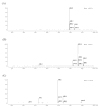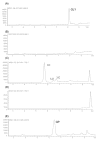Validation of a sensitive LC-MS assay for quantification of glyburide and its metabolite 4-transhydroxy glyburide in plasma and urine: an OPRU Network study
- PMID: 17980680
- PMCID: PMC2696259
- DOI: 10.1016/j.jchromb.2007.10.010
Validation of a sensitive LC-MS assay for quantification of glyburide and its metabolite 4-transhydroxy glyburide in plasma and urine: an OPRU Network study
Abstract
Glyburide (glibenclamide, INN), a second generation sulfonylurea is widely used in the treatment of gestational diabetes mellitus (GDM). None of the previously reported analytical methods provide adequate sensitivity for the expected sub-nanogram/mL maternal and umbilical cord plasma concentrations of glyburide during pregnancy. We developed and validated a sensitive and low sample volume liquid chromatographic-mass spectrometric (LC-MS) method for simultaneous determination of glyburide (GLY) and its metabolite, 4-transhydroxy glyburide (M1) in human plasma (0.5 mL) or urine (0.1 mL). The limits of quantitation (LOQ) for GLY and M1 in plasma were 0.25 and 0.40 ng/mL, respectively whereas it was 1.06 ng/mL for M1 in urine. As measured by quality control samples, precision (% coefficient of variation) of the assay was <15% whereas the accuracy (% deviation from expected) ranged from -10.1 to 14.3%. We found that the GLY metabolite, M1 is excreted in the urine as the glucuronide-conjugate.
Figures




References
-
- Langer O, Conway DL, Berkus MD, Xenakis EM, Gonzales O. N Engl J Med. 2000;343:1134. - PubMed
-
- Moore T. In: Materanal-fetal medicine: principles and practice. 5. Creasy RK, Resnik R, Iams JD, editors. Philadelphia: Saunders; 2004. p. 1023.
-
- Lucas MJ. Obstet Gynecol Clin North Am. 2001;28:513. - PubMed
-
- Sermer M, Naylor CD, Farine D, Kenshole AB, Ritchie JW, Gare DJ, Cohen HR, McArthur K, Holzapfel S, Biringer A. Diabetes Care. 1998;21(Suppl 2):B33. - PubMed
-
- Beischer NA, Wein P, Sheedy MT, Steffen B. Aust N Z J Obstet Gynecol. 1996;36:239. - PubMed
Publication types
MeSH terms
Substances
Grants and funding
LinkOut - more resources
Full Text Sources
Research Materials

